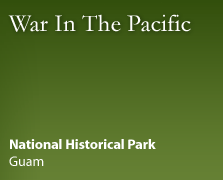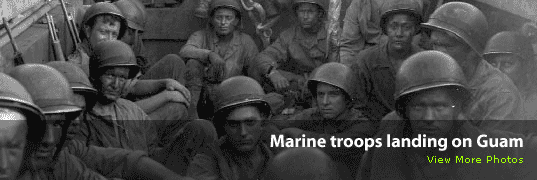| |
The Asan Bay Overlook is the most recently developed unit in our park. It was completed in 1994, in conjunction with the 50th Anniversary commemoration of the Liberation of Guam. This unit features bronze sculptures which depict the events on Guam during the Japanese occupation in 1941-1944. The artist, Eugene Daub, is a sculpture instructor at the Academy of Art College in San Francisco. His father was a soldier in World War II, and the first bas relief has an engraving on the bottom right corner that states ”This one’s for you, dad.”
This area has a view that shows how the Japanese defensive forces dug in, and how the US forces came from the beach and up to secure. Japanese defensive positions were placed on top and on both sides of Asan and Adelup Point. The fortifications of Japanese beach defenses were extensive. On the fringing reef were placed obstacles and mines. The beaches and immediately inland were obstacles and tank traps. Further inland were machine gun positions, pillboxes, heavy weapons, artillery, and coastal defense guns. Artillery, heavy weapons, and machine guns were placed higher inland to shoot down on the beaches. When the United States forces started the invasion on July 21, 1944 the Japanese had perfect observation and firing ports from high ground. The Japanese had strongholds at Adelup Point, Chorrito Cliff, Bundchu Ridge, Fonte Plateau, and Mt. Tenjo. The United States forces were to storm the beachhead and move further inland. This location gives a visitor a good perspective and overview of how the fighting transpired.
Underwater Demolition Teams came in to destroy obstacles before the US Marines landed. There were 12 troop transports containing the 3rd Marine Division and 16 Landing Ships Tank. The bombardment of the island began at 0530 am on July 21, 1944. Over 18,000 various sized shells were expended, and nine thousand rockets launched over the island. Then at 7 am the LST’s moved toward shore in Asan to unload 180 armored landing vehicles full of assault troops. The Japanese had perfect observation and firing points from high ground. But the mission included securing those high positions to make the beachhead secure for US soldiers to live, sleep, eat, and stockpile supplies.
The lead elements of the 3rd Marine Division crossed the reef from 200 to 500 yards offshore and landed on Asan Beach, which was defended by the Japanese 320th Independent Infantry Battalion and naval troops manning the coastal defense guns.
The plan was to fight between Adelup and Asan Points, referred to as “the devil’s horns”.From east to west, two battalions of the 3rd US Marine Regiment landed on Beach Read 1, one battalion of the 3rd US Marine Regiment landed on Beach Red 2, three battalions of the 21st US Marines came ashore on Beach Green, in the middle.And three battalions of the 9th US Marines landed on Beach Blue adjacent to Asan Point. The 3rd Marine Division order called for the 3 regiments to land abreast, capture the high ground immediately inland, and prepare for further operations to the east and southeast. Marines assaulted beaches, took Orote Peninsula, and the land behind Asan and the Force Beachhead Line from Adelup Point to Mt. Chachao/Mt. Tenjo.
When Japanese commanders felt the fighting was favoring a US triumph they initiated banzai charges as a last attempt to overcome the opposition. One such attack occurred on July 25, 1944 shortly before midnight. Japanese soldiers wielding pitchforks, sticks, ballbats, and pieces of broken bottles, together with the normal infantry weapons attacked the US soldiers in an attempt to drive the Americans back into the sea. It had been a severe struggle, but the Americans held their position, and the Japanese break-through attempt had been stopped. Retired Marine Captain Jack Eddy is quoted saying ”Unbelievable. Just unbelievable. It was the most traumatic experience I ever had. When you think about fighting, you think that you’re 100 yards away, but this was pretty gruesome, fighting them from 20 feet away and they’re running all around you and screaming. That was what got to you—they wanted to die. They were willing to sacrifice themselves.” The next day 3500 dead Japanese soldiers were found. This area of Guam was declared secure on July 28, but it took until August 10, 1944 to secure the whole island.
Approximately 55,000 young Marines and Army soldiers invaded Guam. This park contains a memorial wall to honor their sacrifices and the sacrifices of the Chamorros. The memorial wall consists of 90 plaques. The names of the U.S. Marines, Soldiers, Sailors, Airmen, and Coast Guardsmen who died during the Battle for Guam from July 21-August 10, 1944 are 1857. The names of the people of Guam who died as a result of the Occupation of Guam from December 8, 1941- July 21, 1944 are 1122. The names of the people of Guam who suffered personal injury, forced labor, forced march, or internment as a result of the Occupation of Guam from December 8, 1941-July 21, 1944 are 13,163. These are not all the names of those who should be recognized. There is a list complied of additions to be made in the future.
|
|





